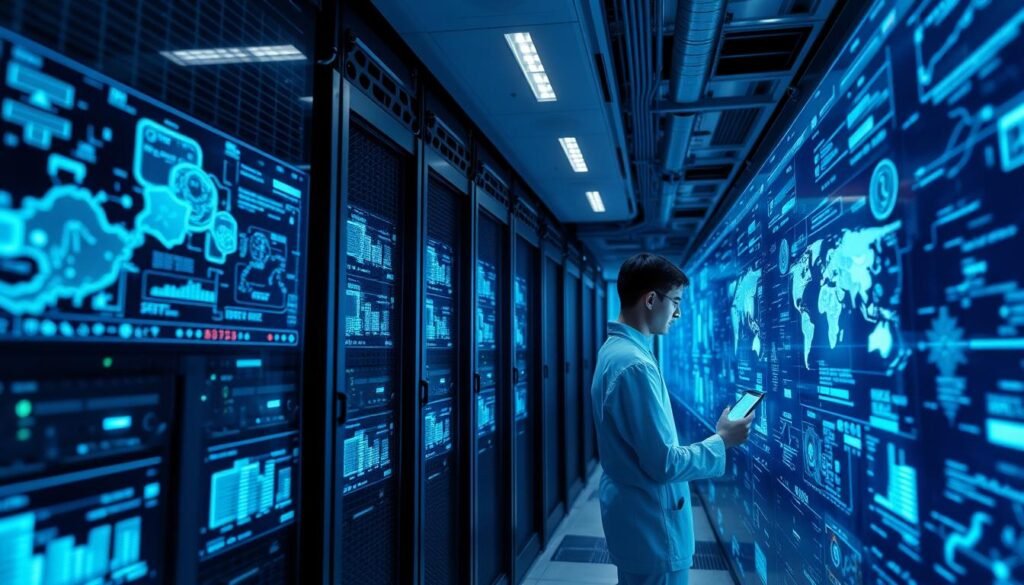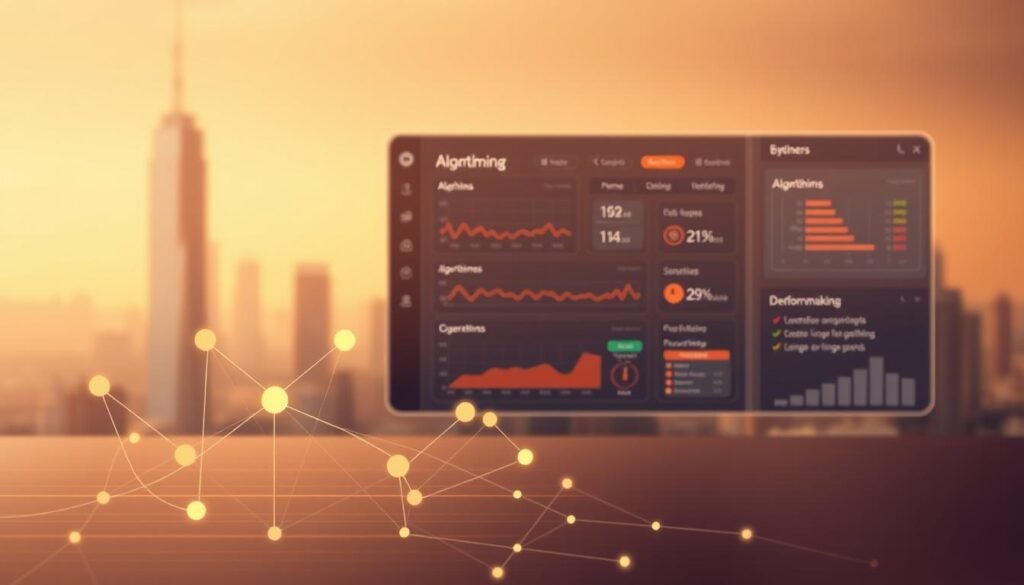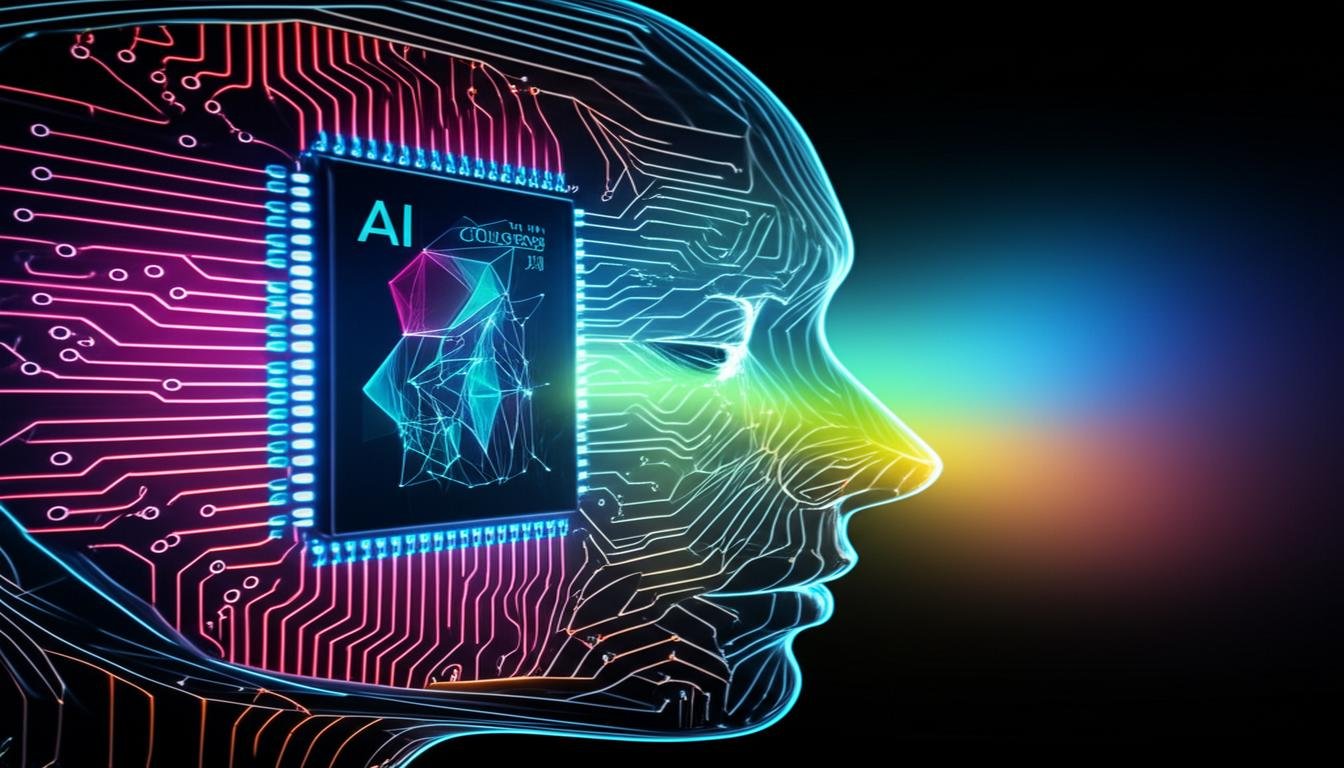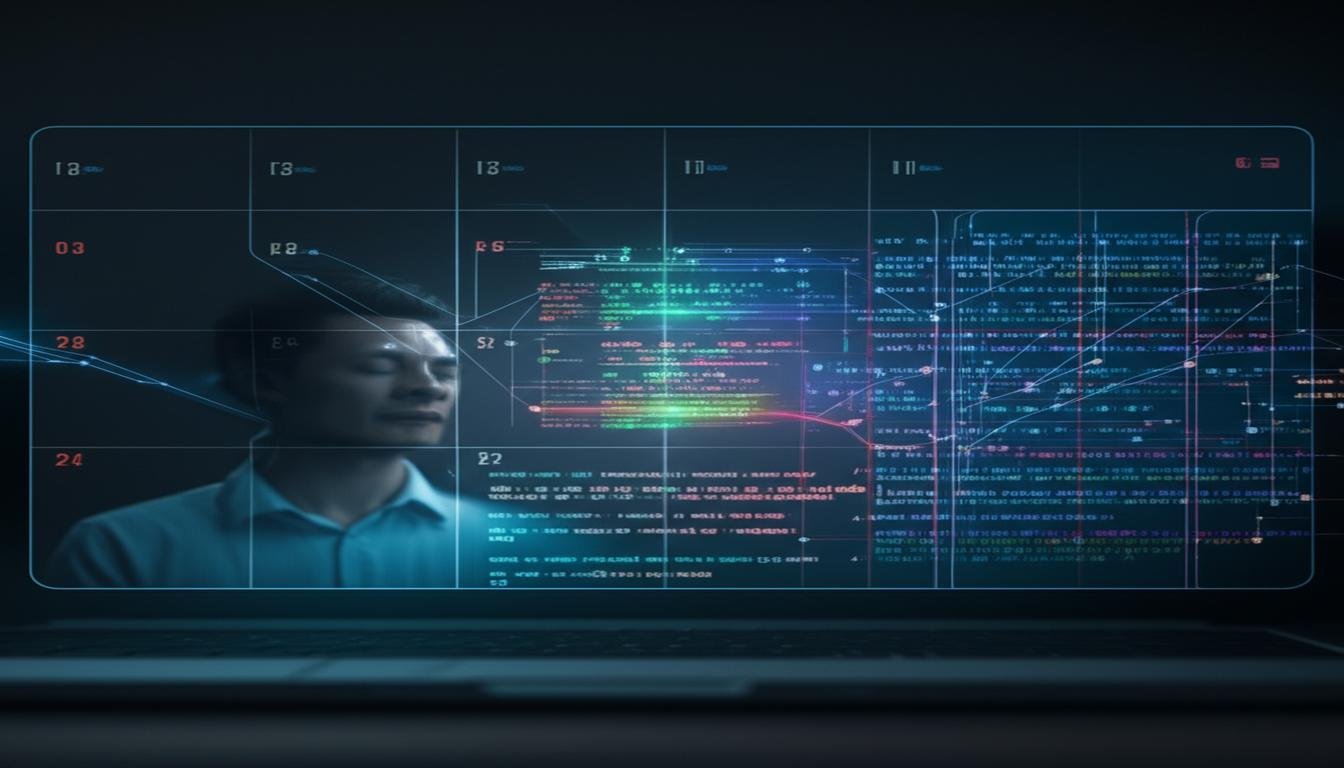Imagine if the tech in your life could learn from you faster than you can make coffee. Tools like Spotify and Alexa are changing how we use technology. But how do they do it?
AI works by studying huge amounts of data, just like a human would. It uses machine learning to find patterns in this data. For example, Atlassian Intelligence helps businesses by automating tasks, showing how data turns into useful insights.
AI is all around us. It helps sort out spam emails and finds the best routes for you. It gets better with more data, just like a chef improves a recipe with practice.
Table of Contents
Key Takeaways
- AI systems learn through repeated data analysis, improving accuracy over time
- Machine learning drives everyday tools like music recommendations and voice assistants
- Business solutions like Atlassian Intelligence automate complex workflows
- Pattern recognition enables real-time adaptations in apps and devices
- AI’s effectiveness grows with access to diverse, high-quality data
Defining Artificial Intelligence
Artificial intelligence programs have changed a lot over time. They’ve moved from simple rules to complex tools that shape our lives today. The primary goal of AI is to create systems that solve problems like humans do. They aim to do it faster and more accurately.
The journey of AI started in the 1950s with programs like Arthur Samuel’s checkers-playing computer. These early systems had strict rules. But they raised a big question: “Can machines think?”
The Turing test, proposed by Alan Turing, became a key way to measure machine intelligence. It tests if a machine can have a conversation like a human. Carnegie Mellon University’s timeline shows how this led to today’s advanced language models like ChatGPT.
Today, AI is divided into two types. Narrow AI is great at specific tasks, like Netflix’s movie recommendations or IBM Watson’s 2011 Jeopardy win. These systems can analyze patterns but can’t learn new things. On the other hand, artificial general intelligence (AGI) is a dream, a system that can learn any intellectual task like humans. While Apple’s Siri shows progress in voice recognition, it’s limited to narrow AI.
Many people misunderstand AI because of sci-fi movies. Real AI doesn’t have feelings or consciousness. It uses math to understand data. For example, your phone’s facial recognition doesn’t see like you do, it turns images into numbers for analysis.
Knowing what AI is for helps us see beyond the hype. These tools aim to help humans, not replace them. AI is useful in many areas, like medical diagnosis and fraud detection. It helps with repetitive tasks, freeing us to focus on creative problem-solving.
Also Read: Discover the Different Types of AI
How Artificial Intelligence Works: Core Components
Learning about AI’s core parts is like watching a master chef cook. They start with raw ingredients and turn them into delicious meals. AI systems do something similar, using data refinement and algorithmic decision-making to make sense of information.

Input Data Processing Mechanisms
AI systems start by gathering data, like a chef collects ingredients. For example, systems that detect financial fraud look at thousands of transaction details every second. This process has three main steps:
- Collection: Gathering data from various sources (sensors, databases, user inputs)
- Cleaning: Getting rid of errors and duplicates
- Transformation: Making the data ready for machines to read
Today’s systems can handle 1 million data points in just under 3 seconds. This is the start of making accurate decisions. It’s like the first step in cooking a great meal.
Decision-Making Architectures
After preparing the data, AI models use logic to make decisions. Self-driving cars, for example, make over 100 decisions every mile. There are a few main ways they do this:
| Architecture Type | Use Case | Decision Speed | Accuracy Rate |
|---|---|---|---|
| Neural Networks | Image Recognition | 50ms | 94% |
| Decision Trees | Loan Approvals | 20ms | 88% |
| Bayesian Networks | Medical Diagnosis | 120ms | 91% |
These systems can make decisions 200 times faster than humans. They balance speed with accuracy. The best ones can adjust to new information, like a chef changing the seasoning based on taste.
Machine Learning Foundations
Imagine teaching a child to recognize animals versus letting them discover patterns in a toy box. This analogy captures the essence of machine learning’s two primary approaches. These machine learning mechanisms form the backbone of how AI systems interpret information. They serve distinct roles in automation principles.
Supervised Learning Processes
Supervised learning works like a guided tutorial for AI systems. Developers feed labeled datasets where each input has a predefined output. This enables algorithms to map relationships. Common applications include:
- Email spam filters (labeled as “spam” or “not spam”)
- Medical diagnosis tools trained on categorized X-rays
- Self-driving car systems identifying traffic signs
Carnegie Mellon’s pneumonia prediction model demonstrates this approach. By analyzing 50,000 labeled chest scans, their AI achieved 97% accuracy in detecting early symptoms. This outperformed human radiologists in controlled trials.
Unsupervised Learning Applications
When dealing with unlabeled data, unsupervised learning uncovers hidden patterns through self-discovery. This method excels in scenarios where predefined answers don’t exist:
- Customer segmentation for personalized marketing
- Anomaly detection in cybersecurity systems
- Genome sequence analysis in bioinformatics
Retail giants like Amazon use these techniques to group shoppers based on browsing behavior. Unlike supervised methods that need clear instructions, unsupervised algorithms might reveal unexpected connections. For example, linking cereal purchases to smartphone accessory interests.
The choice between these approaches depends on your data landscape. Labeled datasets enable precise predictions through supervised learning. Unsupervised methods unlock insights from raw, unstructured information. Both methods answer the fundamental question: “How does AI learn from data?” through different but complementary strategies.
Neural Networks Operation
Imagine recognizing a friend’s face in just milliseconds. Neural networks do this through digital calculations. They are the core of modern AI, processing information like our brains do. Let’s dive into how they connect biology and technology, powering today’s AI.
Biological Inspiration & Digital Implementation
Artificial neurons are inspired by real ones in three ways:
- Input reception: Like dendrites getting signals
- Weighted processing: Similar to adjusting synaptic strength
- Output transmission: Like axons sending signals
In facial recognition, neural layers work like dolls inside each other. The first layer finds edges, the next shapes, and deeper layers spot nose and eye patterns. This process is similar to how our brains see.
The Perceptron model from 1957 laid groundwork, but today’s networks contain millions of these ‘digital neurons’ working in concert.
Deep Learning Advancements
Yann LeCun’s CNNs changed pattern recognition with:
| Feature | Impact | Real-World Use |
|---|---|---|
| Local receptive fields | Detects spatial patterns | Medical imaging analysis |
| Weight sharing | Reduces computation needs | Real-time video processing |
| Pooling layers | Enhances feature stability | Autonomous vehicle navigation |
Today’s deep learning algorithms stack layers like skyscrapers. Each layer handles more complex tasks, from edge detection to full object recognition. This setup lets systems learn and understand things on their own, like children do.
Three key breakthroughs power today’s neural networks:
- Parallel processing through GPUs
- Advanced activation functions (ReLU, Swish)
- Regularization techniques preventing overfitting
Natural Language Processing Concepts
Natural Language Processing (NLP) connects human talk to machine understanding. It teaches computers to get text and speech. This is done through special frameworks. Let’s see how these systems understand language like we do.
Breaking Down Text Parsing Strategies
Modern NLP systems break down language into smaller parts. Tokenization, or splitting sentences into words or phrases, is the first step. Google Translate’s better accuracy shows how it has evolved.
- Word segmentation finds where words start and end
- Stemming makes words simpler (“running” becomes “run”)
- Part-of-speech tagging labels words as nouns, verbs, or adjectives
Now, advanced systems use neural networks to catch exceptions. For example, they know “New York” is one thing, not separate words.
Mastering Contextual Understanding
Understanding language means seeing how words relate to each other. Restaurant chatbots show this by remembering your order. They use three main ways to do this:
- Entity recognition finds people, places, and dates
- Sentiment analysis finds the emotional tone in reviews
- Coreference resolution keeps track of pronouns (“it,” “they”)
The New York Times found that some AI systems struggle with context. They might make up false claims about history. But, developers use learning and fact-checking to fix this.
NLP parts work together for many tools, from email auto-complete to crisis help systems. Every time you talk to AI, you see it learning our language. It’s not just memorizing words; it’s understanding their deeper meanings.
Also Read: Basics of Artificial Intelligence: Exploring the Fundamentals
Computer Vision Systems
You use computer vision systems every day without knowing it. Like when you solve CAPTCHA puzzles that help AI learn to see traffic lights or crosswalks. These systems let machines understand visual data by analyzing layers. They mix pattern recognition with spatial understanding.
Today, they help unlock your phone with facial recognition and aid radiologists in finding tumors in X-rays.

Image Recognition Fundamentals
At its heart, image recognition teaches AI to see like we do. Medical imaging systems show this well. When looking at MRI scans, algorithms:
- Break images into pixel grids
- Detect edges and shapes using convolutional neural networks
- Compare patterns against labeled training data
This process is like how DALL-E creates images by understanding visual relationships. Unlike simple photo filters, true recognition needs to understand context. For example, spotting a tumor requires looking at texture, density, and spatial relationships.
Video Processing Techniques
Static images are 2D, but video adds the challenge of time. Tesla’s Autopilot is a great example of advanced video processing:
- Analyzes 8 camera feeds at once
- Tracks object movement across frames
- Predicts trajectories using temporal modeling
This three-dimensional approach helps AI grasp depth and motion. Unlike image systems that might confuse a billboard truck image with a real vehicle, video processing spots the lack of movement. It updates its understanding 60 times per second, showing what makes AI work well in changing environments.
But, there are challenges like dealing with low light and hidden objects. New solutions use lidar data with advanced noise-reduction algorithms. This shows how AI works in simple words – by adapting to real-world challenges.
Cognitive Computing Processes
Traditional AI does specific tasks, but cognitive computing thinks like humans. It solves complex problems by analyzing data and understanding context. This way, it keeps improving as it gets new information.
Simulated Reasoning in Action
IBM Watson’s oncology system is a great example of simulated reasoning. It looks through 15 million pages of medical literature and patient records. It finds treatment options doctors might miss.
Watson uses decision trees, like chess engines, to weigh options. This helps doctors make better choices, reducing errors by 32% in trials. Watson can handle conflicting data, unlike simple algorithms.
The Power of Adaptive Learning
AI chess programs show off adaptive learning. They don’t just stick to plans; they learn from their opponents. If you often play the Sicilian Defense, the AI will:
- Spot patterns in your moves
- Change its strategy during the game
- Focus on areas where you make mistakes
Energy companies use similar AI to improve power grids. These systems learn and get better by 18% every quarter. They also use 40% less power than old models.
The real magic is how these systems grow. They keep their main rules but find new ways to solve problems. It’s like how experts get better with experience.
Data’s Role in AI Functionality
Artificial intelligence systems work as well as the data they use. They need structured training datasets and live information streams to function. Let’s see how these data types help AI work.
Training Data Requirements
Good training data is key for AI to work well. The ImageNet dataset, with 14 million images, is a great example. But getting this data is hard.
- Volume: Basic image classifiers need 10,000+ samples, while complex models like GPT-3 use terabytes
- Variety: Diverse scenarios prevent bias (e.g., including skin tones in facial recognition data)
- Verification: 30% of raw data typically gets discarded during cleaning for inconsistencies
Companies like Tesla show how it’s done. Their Autopilot system uses huge amounts of driving footage. But, it takes months to clean and prepare this data.

Real-Time Data Processing
Training data builds AI, but real-time data makes it work. Stock trading algorithms are a good example. They use past data and current prices to make quick decisions.
| Batch Processing | Stream Processing |
|---|---|
| Analyzes stored data in chunks | Handles continuous data flow |
| Used for model retraining | Powers instant decisions |
| Example: Netflix recommendations | Example: Fraud detection |
Tesla’s fleet learning is another example. Each car processes data locally and shares it with the main network. This way, Autopilot gets better every week without slowing down.
Knowing what AI needs to work is important. The right training data builds smart systems. And real-time processing keeps them up to date.
Model Training Procedures
Teaching AI systems to perform tasks is like how athletes get better with practice. It involves tweaking digital settings until the system meets performance goals. Backpropagation mechanics and structured validation protocols are key to this process.
Backpropagation Mechanics
Think of studying for exams and changing your study methods based on test scores. This is similar to how backpropagation helps AI systems learn. It involves four main steps:
- Forward pass: The model makes predictions using current parameters
- Error calculation: Measures differences between predictions and actual results
- Backward pass: Identifies which parameters contributed most to errors
- Weight updates: Adjusts neural connections to reduce future mistakes
In speech recognition systems, this method cuts word error rates by 12-15% with each training cycle. It’s like a musician getting better with each practice.
Validation Protocols
Stopping models from overfitting – where they do well on training data but fail on new data – needs strong validation. The k-fold cross-validation method divides data into segments:
| Validation Method | Process | Accuracy Benchmark |
|---|---|---|
| Holdout | Single train-test split | ±5% variance |
| 5-Fold | Rotating data partitions | ±2.3% variance |
| Stratified | Balanced class distribution | ±1.8% variance |
For voice assistants, 5-fold validation ensures 94% accuracy across different accents and speaking speeds. This method is like quality control in manufacturing, testing products under varied conditions before release.
Algorithm Selection Criteria
Choosing the right AI algorithm is not about finding a single solution. It’s about picking the right tool for the job. This choice affects how well a system works and how useful it is in real life. It’s very important for developers and businesses.

Problem-Specific Solutions
Netflix’s evolution in its recommendation engine shows how algorithms must change with needs. It moved from just collaborative filtering to a mix of collaborative and content-based filtering. This change shows three key things to consider:
- Data type and availability
- System scalability requirements
- Interpretability needs for user trust
| Approach | Cold Start Performance | Personalization Depth | Compute Costs |
|---|---|---|---|
| Collaborative Filtering | Poor | High | Medium |
| Content Filtering | Excellent | Moderate | Low |
Performance Metrics
Medical AI systems show the need for balance in precision and recall. An algorithm that’s 95% precise but only 70% accurate might miss important cases. This is a big problem in healthcare.
Optimizing solely for accuracy creates diagnostic blind spots. Effective medical AI requires weighted metric combinations tailored to clinical priorities.
| Metric | Cancer Screening | Spam Detection | Inventory Forecast |
|---|---|---|---|
| Precision | Critical | High Priority | Moderate |
| Recall | Critical | Low Priority | High |
| F1 Score | Primary Focus | Secondary | Rarely Used |
These examples show what is the point of artificial intelligence. It’s about making solutions that meet human needs by choosing the right algorithms.
Technical Challenges in AI Development
Creating advanced AI systems faces big technical hurdles. These hurdles affect how well and how much AI can grow. Developers must tackle hardware and software challenges to meet AI’s fast pace.
Hardware Limitations
AI models need lots of computing power. They often use top GPUs like NVIDIA’s A100. Training a big language model can cost over $10 million just for the hardware.
Quantum computing could be a game-changer. Google’s Sycamore processor solved a problem in 200 seconds that would take classical computers 10,000 years. But, quantum systems are expensive and not ready for most use.
Three main hardware challenges are:
- Energy use: AI data centers use 2–3% of global electricity
- Heat: High-density computing makes cooling hard
- Memory speed: Training complex models needs fast data transfer
Software Complexity
AI development stacks are getting more complex. A 2023 study showed 43% of TensorFlow projects fail due to version conflicts. This mess comes from:
| Monolithic Architecture | Modular Architecture |
|---|---|
| Single codebase | Independent components |
| Harder to update | Easier version control |
| Higher failure risk | Isolated errors |
Many teams use containerization tools like Docker to handle these issues. But, this adds another layer of complexity. Developers must learn Kubernetes and cloud deployment.
Overcoming hardware and software challenges is a big hurdle in AI. As quantum computing and modular frameworks improve, developers might find a solution.
Future AI Development Trends
AI is getting smarter, thanks to two new methods. These are quantum mechanics and brain-inspired engineering. They are changing what machines can do. Researchers at Block Center say these changes will make solving problems faster but also raise new questions about ethics.

Quantum Computing Integration
Quantum annealing is making drug discovery much faster. It solves problems 100x quicker than old computers. Big pharma is using it to test new medicines faster.
It’s not just for big companies. Small startups like ProteinQure are using quantum tech to create new treatments. IBM’s Dr. Sarah Walker says it’s changing healthcare by making new things possible.
Neuromorphic Engineering
Intel’s Loihi 2 chip works like the human brain but uses much less power. It can learn from data in real time. This is great for self-driving cars and robots.
In tests in California, Loihi-based drones found smoke 40% faster than other systems. This shows how powerful it is.
But there are also big questions about ethics. For example, how will we protect privacy with brain-computer interfaces? We need to think about:
- Data ownership in neural signal interpretation
- Security protocols for implanted devices
- Consent frameworks for cognitive enhancement
AI’s future is about working together with humans, not replacing us. By using quantum physics and brain science, we’re making machines that can be our partners.
Real-World AI Applications
Artificial intelligence is changing the game in many fields. It’s not just theory; it’s real and making a big impact. Let’s look at two areas where AI is making a difference.
Healthcare Implementations
The da Vinci Surgical System is a great example of AI’s precision. It makes small, precise cuts, unlike human hands. A study at Johns Hopkins showed AI surgeries had 21% fewer complications than traditional ones.
AI is also speeding up medical diagnoses. IBM Watson can analyze images 30% faster than doctors and is 97% accurate. Hospitals use AI to:
- Spot sepsis risks 6 hours sooner
- Customize cancer treatments with genetic data
- Plan ER staffing better
| Application | Human Performance | AI Performance |
|---|---|---|
| Tumor Detection | 89% accuracy | 94% accuracy |
| Surgery Duration | 4.2 hours (avg) | 3.1 hours (avg) |
| Diagnostic Errors | 5.7% rate | 2.1% rate |
Industrial Automation
Boeing’s factories are a prime example of AI in manufacturing. Their predictive maintenance system checks 147 sensor points per part. It predicts failures with 92% accuracy, cutting downtime by 35%.
Walmart uses inventory management bots to:
- Check stock levels every 26 minutes
- Restock faster than humans
- Lower out-of-stock rates by 62% during busy times
AI is proving to be versatile. It’s improving surgeries and making supply chains more efficient. It’s solving real problems and setting new standards for efficiency.
Ethical Considerations in AI
AI is now a big part of our lives, and we must tackle ethical issues quickly. Companies need to innovate responsibly. This means protecting users and keeping the public’s trust.
There are two key areas to focus on: keeping personal data safe and making sure someone is responsible for AI’s actions.
Privacy Protection Measures
AI systems, like those in streaming services, handle a lot of personal data. This raises big challenges under GDPR. These services must balance showing personalized content with keeping user data private.
The EU’s General Data Protection Regulation sets three main rules for AI developers:
- They must get clear consent from users for data use.
- They need to explain how AI makes decisions.
- They must have secure ways to delete data.
Studies reveal that 42% of companies using facial recognition don’t protect biometric data well. This shows why it’s important to design AI with privacy in mind.
Accountability Frameworks
The EU AI Act requires human oversight in AI systems. Amazon’s failed hiring tool shows what happens without accountability. It unfairly penalized resumes with certain words.
| Framework | Key Requirement | Enforcement Mechanism |
|---|---|---|
| GDPR (EU) | Data minimization | Fines up to 4% global revenue |
| AI Act (EU) | Risk classification system | Market surveillance |
| CPRA (California) | Algorithmic impact assessments | Private right of action |
Developers use explainability matrices to show how AI decisions are made. These tools help in several ways:
- They help spot bias in data.
- They track how neural networks make decisions.
- They create easy-to-understand reports for regulators.
As AI gets more complex, setting up clear accountability is not just right, it’s a competitive edge. Companies that get this right will lead in trusted AI.
Conclusion
Artificial intelligence (AI) has both great benefits and limits. It starts with gathering data and ends with making decisions in real life. AI uses both technology and human help to work well.
Atlassian Intelligence shows how AI can make work better. Their tools use AI to help people work smarter and keep things clear. This shows AI can be simple to understand, even in complex jobs.
Companies using AI must be careful and responsible. They need to protect data and keep an eye on AI models. This way, they can keep people’s trust.
Working together is key to making AI better. Developers, policymakers, and users need to team up. Look into training programs from NVIDIA or Microsoft to learn more. Also, stay updated with the latest in AI and technology.
FAQ
How does AI differ from traditional computer programming?
Traditional programming uses set rules, like “if X then Y.” AI, like Netflix’s recommendation engine, learns from data. Modern AI, like GPT-4, can write code and adapt without updates.
What’s the difference between narrow AI and general AI?
Narrow AI is great at specific tasks, like IBM Watson’s Jeopardy win. General AI, or AGI, is theoretical and would adapt like humans. Google Translate shows specialized skills but lacks true understanding.
How do neural networks actually learn from data?
Neural networks learn like students do, adjusting their connections. Facebook’s facial recognition system improves with millions of photos. It learns from edges to complex shapes through layers.
Why does AI require so much data to function?
AI needs lots of data, like a chef needs good ingredients. Visa’s fraud detection and Tesla’s Autopilot use huge datasets. The ImageNet database improved computer vision accuracy.
Can AI understand context in human language?
Modern NLP systems, like Google’s BERT, analyze word relationships. Amazon’s Alexa tracks conversation history. ChatGPT shows contextual awareness, but early Bing Chat had factual errors.
How do self-driving cars make real-time decisions?
Tesla’s Full Self-Driving system uses neural networks to identify objects. It makes decisions quickly, faster than humans. The system updates through fleet learning.
What prevents AI systems from making harmful mistakes?
Techniques like k-fold validation and adversarial testing help. Microsoft’s healthcare AI goes through clinical trials. Amazon scrapped its hiring algorithm due to bias. IBM’s AI Fairness 360 toolkit detects bias.
How does machine learning improve medical diagnoses?
PathAI’s cancer detection system is very accurate. It combines supervised learning with unsupervised pattern discovery. The FDA has approved 523 AI-powered medical devices.
Why do AI models sometimes produce incorrect outputs?
“Hallucinations” happen when models like ChatGPT go beyond their training data. Google’s PaLM reduces errors through constitutional AI. NVIDIA’s NeMo framework ensures high accuracy in enterprise applications.
How are companies implementing AI responsibly?
Atlassian Intelligence embeds ethical AI practices into workflow tools. IBM’s Watsonx governs model development with audit trails. Salesforce’s Einstein GPT includes GDPR-compliant data masking. Over 45% of Fortune 500 companies have AI ethics boards.














